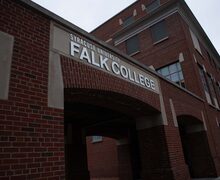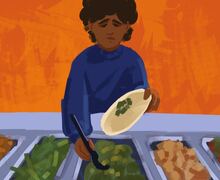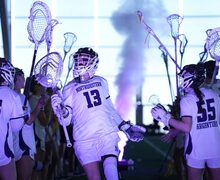Syracuse University researchers work to understand ALS disease mechanism
Riley Bunch | Staff Photographer
ALS is a disease that can weaken muscles and affect physical functions.
A pair of Syracuse University researchers are working to understand a disease mechanism of ALS, which can weaken muscles and affect physical functions.
Carlos Castañeda, an assistant professor of biology, chemistry and interdisciplinary neuroscience, and Thuy Dao, a postdoctoral researcher in chemistry, are studying the UBQLN2 gene, which can be mutated and cause ALS.
The Daily Orange spoke with Castañeda about his team’s research on understanding ALS mechanisms.
The Daily Orange: What is ALS?
Carlos Castañeda: ALS is Amyotrophic Lateral Sclerosis, otherwise commonly known as Lou Gehrig’s disease. It’s a motor neuron disease. So what happens is that your motor neurons in your brain or spinal cord, they die, and when they die you lose the ability to control your movements. It’s more of an adult onset disease, so most people that get it are in their 50s and 60s.
There are a few cases where people get it when they’re a lot younger. But what happens is you slowly start to lose control of your hands or limbs. Maybe they’re a little spastic, and then eventually you become paralyzed since they have to be in a wheelchair, and then your cognitive functions and everything are still working just fine.
But as far as I can tell, it’s like you’re trapped inside your body that no longer can do what it used to be able to do. People who have ALS, what can happen to them is they will die because they apparently lose control of their breathing muscles, and that’s why it’s not a curable disease yet.
The D.O.: What does Ubiquitin and UBQLN2 have to do with your ALS research?
C.C.: The way I understand it, what happened with ALS maybe 40 to 50 years ago, when they started studying this, they studied SOD1 which is another protein: Superoxide dismutase. That was one of the first early connections between a gene and ALS.
As time progressed and people discovered more genes are related to disease, they began realizing that there are two kinds of genes that would get mutated in a disease. They were like protein homeostasis. That basically means how your proteins get cleaned up inside your cells, so protein quality control.
What happens with quality control, is in your cell, your proteins are being made, and they’re being broken down. That’s a normal process. But part of that process gets disrupted. Then you can have a buildup of like protein aggregates, or clumps, and that is what can sometimes lead to these plaques or inclusions that people find inside these motor neurons of people that have ALS or other degenerative disorders like Alzheimer’s or Parkinson’s.
They found that there are lots of genes that are related to protein quality control and ALS. UBQLN falls into that category. UBQLN2 is a parallax — basically, one type of UBQLN that is found in the body. It’s mostly expressed in brain spinal cord, so like in your nervous tissue. And that protein can get mutated a few times. It has been linked to familial ALS, so if the protein is mutated, it can give rise to certain cases of familial ALS, x-linked ALS and also sporadic ALS.
The D.O.: Can you explain familial and sporadic ALS?
C.C.: Familial ALS is ALS that is related to a gene that’s been mutated in a family. So mom has it, maybe grandmother has it. So like there’s evidence that (those) particular genes are mutated in the family. Sporadic ALS is when there’s no genetic mutation, at least none that’s obvious. So it’s like an environmental factor, possibly, that could cause disease.
The D.O.: What kind of environmental factors (could cause ALS)?
C.C.: Stress is one of those. It could be something else in the environment, it could be sleep. Those are things that people really don’t understand yet. Most of the cases of ALS are sporadic, so 90 percent of them are sporadic, I’d say about 10 percent of them are familial.
That’s the other problem most of the time. When people study disease, they look for a gene that’s been mutated, and so they try to assess what does that mutation do on that gene.
Why we got interested in UBQLN is because when I was in postdoc, I studied a lot of ubiquitin stuff, so I knew of ubiquitin, and I’ve always been interested in how ubiquitin interacts with other proteins. UBQLN is one of those proteins that interacts with ubiquitin, and that’s where we got interested in that system. But to make things even more interesting, UBQLN is also thought to interact with RNA binding proteins.
Published on March 21, 2018 at 10:10 pm





